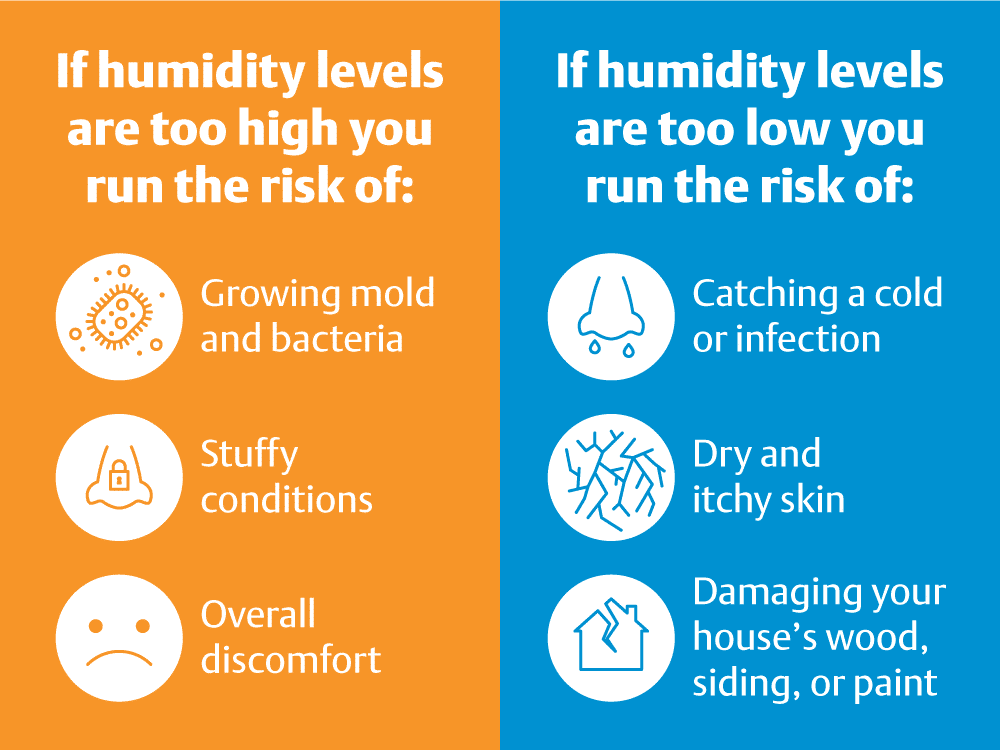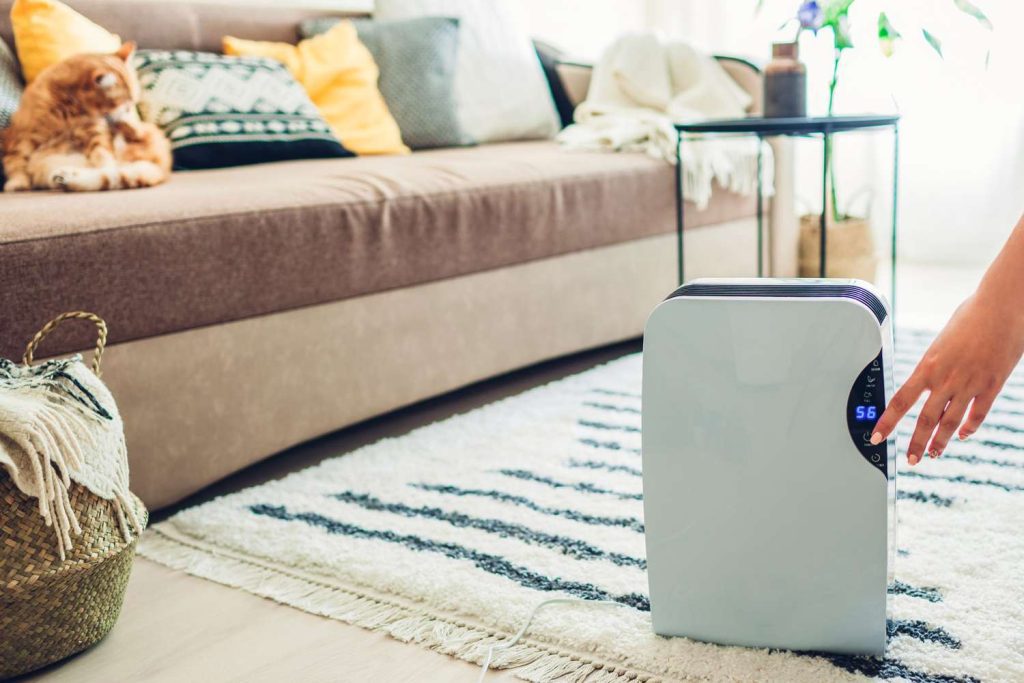You may have high humidity levels if your house always feels damp and sticky.
Luckily, there are simple and effective ways to reduce humidity in your home.
This article will discuss ten practical tips for lowering humidity, from dehumidifiers and air conditioning to improving ventilation and controlling moisture sources.
Say goodbye to that uncomfortable and muggy feeling in your house by following these easy steps!
Review contents
How to Lower Humidity in Your House
Introduction
High humidity levels in your house can be uncomfortable and lead to mold growth, musty odors, and damage to your belongings.
Fortunately, several effective ways exist to lower humidity in your house and create a more comfortable living environment. This article will explore ten methods you can implement to reduce humidity and maintain a healthy and pleasant indoor atmosphere.
Signs of High Humidity
Before we delve into the various strategies for lowering humidity in your house, we must identify the signs of high humidity.
Some common indicators include condensation on windows, damp or clammy feeling in the air, musty odors, and difficulty in cooling down your living space.
If you notice any of these signs, you likely have high humidity in your house and should take steps to address the issue.
Why Lowering Humidity is Important
Lowering humidity in your house is essential for a variety of reasons. High humidity can promote the growth of mold and mildew, which can lead to respiratory issues and allergies. It can also cause damage to your furniture, wooden floors, and other belongings.
Additionally, high humidity can make your home feel hotter than it is, leading to discomfort and increased energy usage. Reducing humidity levels can create a healthier and more comfortable living environment for you and your family.
1. Proper Ventilation
Open Windows and Doors
One simple and effective way to lower humidity in your house is to open windows and doors to allow for better airflow.
This will help expel humid air and bring fresh air from outside. When the weather permits, open windows and doors in your house to encourage cross-ventilation and promote air circulation.
Use Exhaust Fans
Proper ventilation can also be achieved by using exhaust fans in areas where humidity accumulates, such as the bathroom and kitchen.
Please turn on the exhaust fans while showering or cooking to remove the moist air and prevent it from spreading throughout your house. Ensuring your exhaust fans are properly functioning and clean to maximize their effectiveness is essential.
Install Attic Ventilation
In addition to opening windows and using exhaust fans, installing attic ventilation can help to reduce humidity levels in your house. Attics can trap heat and moisture, which can then seep into your living space.
Installing attic vents or a whole-house fan can promote better air circulation and prevent excessive humidity from affecting the rest of your house.
2. Use Air Conditioning
Set Your Air Conditioner to a Lower Temperature
Air conditioning is an effective way to lower humidity in your house, as air conditioners cool the air and remove moisture.
Set your air conditioner to a lower temperature to create a drier and more comfortable indoor environment. This will help to prevent the buildup of humidity, especially during hot and humid weather conditions.
Maintenance of Air Conditioning Units
To ensure that your air conditioning unit is functioning optimally, it’s essential to perform regular maintenance.
Replace or clean the air filters as recommended by the manufacturer to improve the efficiency of your unit. Additionally, have a professional inspect and service your air conditioner annually to identify any issues and ensure it operates at its best.
3. Dehumidifiers
Types of Dehumidifiers
Dehumidifiers are appliances specifically designed to remove excess moisture from the air. There are two main types of dehumidifiers: refrigeration dehumidifiers and desiccant dehumidifiers.
Refrigeration dehumidifiers cool the air and collect the condensation, while desiccant dehumidifiers use a drying agent to absorb moisture. Consider your specific needs and the size of your house when choosing which type of dehumidifier to invest in.
Placement of Dehumidifiers
Proper placement of dehumidifiers is crucial to maximize their effectiveness. Position them in areas where humidity is a concern, such as basements, laundry rooms, or other areas prone to moisture buildup.
It’s recommended to have one dehumidifier per room for optimal humidity control. Ensure that the dehumidifier is placed away from walls and furniture to allow for proper air circulation and to avoid obstructing its intake and exhaust vents.
Regular Maintenance
Regular maintenance is necessary to ensure the longevity and efficiency of your dehumidifiers. Empty the water reservoir regularly to prevent overflow or the growth of bacteria.
Clean the air filters and coils according to the manufacturer’s instructions to remove any dust or debris hindering the dehumidifier’s performance. Keeping your dehumidifier well-maintained can lower humidity levels effectively and efficiently.
4. Houseplants
Choose the Right Houseplants
Believe it or not, certain houseplants can help lower your house’s humidity levels. Plants such as Boston ferns, English ivy, and peace lilies naturally absorb moisture from the air through their leaves.
Additionally, these plants can improve indoor air quality by reducing levels of pollutants. Be sure to choose houseplants that thrive in the conditions of your home and are suitable for your lifestyle.
Use a Dehumidifier Near Houseplants
To further maximize the benefits of houseplants in reducing humidity, consider placing a small dehumidifier nearby. This will help to remove excess moisture from the air, enhancing the effectiveness of the plants in maintaining optimal humidity levels.
Remember to monitor the water levels in the dehumidifier and the plants to maintain them appropriately.
Avoid Overwatering
While houseplants can aid in lowering humidity, it’s important to avoid overwatering them. Excessive watering can lead to moisture accumulation and create the opposite effect, increasing humidity levels.
Follow the recommended watering guidelines for each specific plant, and be mindful of any signs of overwatering, such as yellowing leaves or overly damp soil.
5. Ensure Proper Drainage
Inspect and Clean Gutters Regularly
Proper drainage prevents excess moisture from accumulating around your house’s foundation. Inspect and clean your gutters regularly to ensure they are not clogged with leaves or debris, as this can inhibit their ability to divert rainwater away from your house. Maintaining clean and functioning gutters can minimize the risk of water pooling near your foundation and causing humidity issues.
Extend Downspouts
Consider extending your downspouts to enhance drainage further and minimize the risk of water seeping into your house. This will help direct rainwater further away from your foundation, reducing the chances of pooling near your house. Extending downspouts and ensuring proper drainage can lower humidity levels and protect your home from damage.
Install a French Drain
Installing a French drain can be an effective solution in cases where drainage issues persist. A French drain is a trench filled with gravel or rock that helps to redirect water away from your foundation.
This drain is typically equipped with perforated piping to facilitate water flow. Installing a French drain can help alleviate water-related humidity problems and ensure the stability of your house’s foundation.
6. Fix Leaks and Drips
Inspect and Repair Plumbing Leaks
Leaks and drips from plumbing fixtures can contribute to high humidity levels in your house. Inspect all plumbing connections, pipes, and faucets for any signs of leaks or drips.
Address any identified issues promptly by repairing or replacing the affected parts. By fixing plumbing leaks, you can prevent the continuous release of moisture into your living space and effectively lower humidity levels.
Fix Leaky Roofs
Roof leaks can result in water seeping into your house, causing structural damage and increased humidity levels. Inspect your roof regularly for any signs of leaks, such as water stains or deteriorated shingles.
Address any identified issues by replacing damaged or missing shingles or hiring a professional to repair the leak. You can prevent water intrusion and maintain lower humidity levels by fixing leaky roofs.
Repair or Seal Cracks in the Foundation
Cracks in your house’s foundation can allow water to seep into your living space and contribute to high humidity. Inspect your foundation for visible cracks and promptly repair them using an appropriate sealant.
By sealing foundation cracks, you can prevent water from entering your house and minimize the risk of moisture-related issues.
7. Use Vapor Barriers
Install Plastic Sheeting in Crawl Spaces
Crawl spaces can be a significant source of excess moisture in your house. Consider installing a vapor barrier, such as plastic sheeting, in your crawl spaces to combat this. This will help to prevent ground moisture from evaporating into your living space. Ensure the plastic sheeting is installed correctly and covers the entire area to effectively lower humidity levels.
Use Vapor Barrier Paint
In addition to using plastic sheeting in crawl spaces, you can also use vapor barrier paint on walls in areas prone to high humidity, such as basements or laundry rooms. Vapor barrier paint contains unique ingredients that help to block moisture from passing through walls, reducing the chances of humidity-related issues. Apply the paint according to the manufacturer’s instructions, and consider using a dehumidifier alongside the vapor barrier paint for optimal results.
Seal Concrete Floors
Concrete floors can release moisture into your living space, contributing to high humidity levels. To minimize this, consider sealing your concrete floors with a waterproof sealant. This will create a barrier that prevents moisture from evaporating into your house.
Consult a professional to determine the most suitable sealant for your specific floor type, and follow the application instructions carefully to achieve the best results.
8. Reduce Moisture in Bathrooms
Run Bathroom Fans
Bathrooms are notorious for accumulating moisture due to showers and baths. To reduce humidity levels in your bathroom, habitually run the exhaust fan during and after bathing.
The fan will help to expel moist air and prevent it from spreading throughout your house. Also, leave the bathroom door open for better airflow and quicker moisture dissipation.
Use Bathmats or Rugs
Placing bathmats or rugs on your bathroom floor can help absorb excess moisture and prevent it from lingering in your bathroom.
Make sure to choose absorbent materials that can easily be washed and dried. Regularly clean and dry the bathmats or rugs to prevent the growth of mold or mildew, which can worsen humidity issues.
Wipe Down Surfaces
After showering or bathing, take a few minutes to wipe down the surfaces in your bathroom with a dry towel or squeegee. This will help to remove any residual moisture and prevent it from affecting the overall humidity levels in your house. Pay special attention to walls, windows, and other areas where condensation accumulates.
10. Control Humidity in the Kitchen
Cover Pots While Cooking
Cooking generates a significant amount of moisture in the air, contributing to high humidity levels in your kitchen.
Cover pots and pans while cooking to minimize the steam release into the air to reduce this. This simple practice can effectively maintain lower humidity levels and prevent moisture-related issues.
Use Exhaust Fans
Like the bathroom, using exhaust fans in the kitchen can help expel moist air and reduce humidity. Turn on the exhaust fan while cooking and keep it running for a short period afterward to ensure that any residual moisture is eliminated. Regularly clean and maintain the exhaust fan to maximize its efficiency.
Avoid Overboiling Water
When cooking, be mindful of the amount of water you boil. Overboiling can result in excessive steam and release more moisture into the air, contributing to higher humidity levels.
Take care to boil only the necessary amount of water, and promptly remove pots from the heat once boiling is achieved. By avoiding overboiling, you can effectively minimize the amount of moisture released into your kitchen.
By implementing these ten strategies, you can lower humidity levels in your house and enjoy a more comfortable and healthy living environment. Remember to tailor these methods to your specific needs and the conditions of your home.
With a proactive approach and regular maintenance, you can effectively combat high humidity and create an ideal indoor atmosphere for you and your family.








































